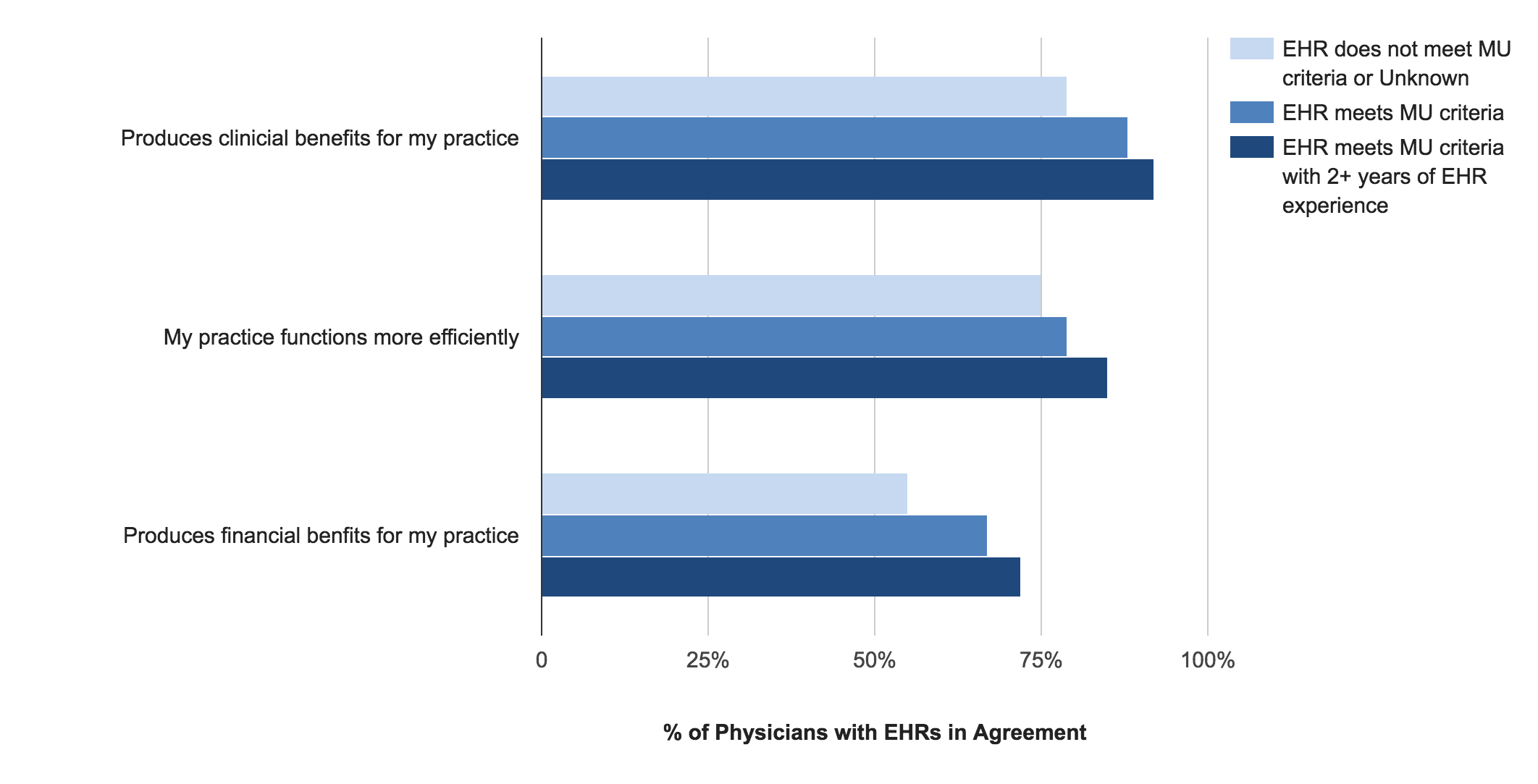The Benefits of Electronic Health Records
Electronic Health Records are disrupting today’s healthcare industry. Find out what’s so special and how EHR can help optimize treatment processes.

Less than 5 years ago a visit to a doctor involved filling in tons of paperwork, describing your complaints and symptoms over and over again and getting a prescription note in highly-indistinguishable writing.
Tremendously long waiting time, lost records and zero treatment understanding of the treatment plan were part of the deal too.
Today, we are witnessing a major shift towards better healthcare through digitalization and the adoption of robust software systems to streamline the most common operations. Namely, Electronic Healthcare Records or EHR development has been on the rise.
In 2012 only 6% of healthcare providers have had an EHR system in place. Today, the number is heading closer to 59%. And there are some really good reasons for such rapid growth.
Benefits of Electronic Health Records for Healthcare Providers
Transitioning to a fuller EHR/EMR solution, which goes beyond just organizing and storing patient, data can benefit your organization on multiple levels. By now the majority of physicians using EHR systems have already reported the positive gains such as improved efficiency, clinical and financial management benefits:

EHR Benefits For Patients
Romexsoft team would like to propose a closer look at what exactly goes into these benefits of EMR and EHR systems.
Reduced Paperwork and Diminished Storage Issues
Arguably, that’s one the most immediate and tangible advantages of electronic medical records your practice will experience. Once the staging and transition stage is over, your clinic suddenly goes paperless. What a breeze!
Considering that the administrative and paperwork typically accounts for one-sixth of their work time (often underpaid or not paid at all), your staff will definitely appreciate the streamlined efficiency an EHR brings to the process. The majority of physicians have reported that their morale and job satisfaction has improved after the EHR adoption as they could now waste less time on routines and focus on delivering better healthcare and establish better patient-to-doctor relationships.
The offices become less cluttered as the need to store all the papers is eliminated. After all, a clutter-free space – is a more productive space!
Improved Care Coordination and Overall Increased Quality of Services
On average, a patient interacts with 3 to 5 different healthcare specialists during a hospital visit. As a result, each member of your team tends to have limited interactions with the patience and, hence, develop a somewhat incomplete view of them. As a result, the team’s overall view of the patient becomes clustered, with incomplete data and fragmented knowledge of the symptoms.
An EHR system in place can easily solve this problem as it offers the complete picture to anyone on the healthcare team in just one click. A custom-built system organizes the patient files and auto-updates it – meaning everyone is always up to date on the treatment, medication and planned visits. You can, for instance, set up notifications to alert respective providers when the patient is at the hospital and proactively follow up.
This kind of streamlined coordination is particularly important in the following cases:
- When a patient is seeing multiple doctors at the same time.
- When a patient is in transition between different care settings.
- When a patient is in need of emergency treatment and the team lacks the full clinical picture.
EHRs make all the patient information easily available to all the parties involved, which reduces the number of unnecessary tests and can reduce medical errors.
Additionally, all your staff will be informed on the treatment plan, which eliminates the cases when two specialists are treating the same condition.
You can incorporate the following functionality into your EHR system for the optimal results:
- Up-to-date allergy and medication lists, updated in one click.
- Standardized templates to organize all patient data, order sets and care plans.
- Notification panel for custom events.
- Access permission management system to ensure better information sharing.
- Electronic prescribing, which would improve the coordination between physicians and pharmacies and reduce the number of lost or misleading prescriptions.
Streamlined Workflow Increases Productivity
As already mentioned, EHRs drastically reduce the amount of required paper and administrative work both for your healthcare team, patients, and the front desk staff.
Fewer forms to fill means that a specialist can devote more time to the patient without transcribing everything they say. Patients won’t need to go over again each time and explain their condition to a new clinician. The doctor will also have immediate access to the past records and will ask the right type of questions based on the earlier treatment a patient has received.
You can build in a custom notification system to remind patients of their visits e.g. 14/7/1 day in advance, which will reduce the number of missed appointments and the staff frustration coming with it. Additionally, auto-reminders can notify patients about required annual screenings and remind them of the checkups. From a clinician standpoint that’s also a major benefit in terms of keeping a proper work-life balance. Dr. Karen Smith shares her perspective on EHR adoption:
“I can review 50 labs on a Saturday while I’m doing the laundry. I review my labs online, and if I find someone needs to go to the hospital right away, I pick up the phone and call them. If it’s a problem that we need to address within 48 hours, I’ll put an alert message on my system, so that the person automatically gets a telephone call or an email. The alert informs the patient that an appointment has already been scheduled for them, allowing the patient to get the care he or she needs with a much faster turnaround”.
Billing and insurance claims can be conducted more efficiently with an integrated patient tracking functionality, meaning reduced load for your administration. Speaking of which…
Revised Outpatient Care Costs and Financial Incentives
EMR software development can be a costly investment for your institution, not to mention the additional spendings involved during the switching period. However, this investment largely pays off in the long run.
An EHR will likely save you from such common costs as medical errors ($19.5 billion annually nationwide) and over $1 trillion a year for lost productivity. According to a recent study conducted by the University of Michigan estimated an average 3% saving per patient within those practices, who actively use EHRs.
Using a comprehensive custom EHR will not only reduce the obvious spending on paper and stationery but also eliminate the following costs:
- Maintaining and paying for a number of software products and integrations.
- IT support and management for non-compatible solutions and those, which stopped functioning after one of the product upgrades.
If you choose to implement an online patient billing via the patient portal, your institution will also receive payment faster within a higher frequency and incomplete amounts which can justify the high cost to develop an EMR system.
If footing an EHR web development bill seems too much right now, your institution can always take advantage of the Medicare EHR Incentive Program and Medicaid EHR Incentive Program if your institution meets the eligibility criteria. So far, the hospitals have received over $2 million in funding.
While the benefits for adopting an EHR for your practice now seem rather obvious, let’s have a closer look on the rewards a patient will receive apart from better, faster and more efficient treatment.
EHR Benefits For Patients
Digitalizing all the patient data not only leads to fewer medical errors, faster diagnosis and more efficient treatment plans, but also carries additional value for the patients:
Transparency
In 2014, 64% of hospitals allowed their patients to access, view, download and transmit their personal health records. This way a patient could always get in touch with another practitioner and present their dossier effortlessly or talk with a trusted person over their condition.
Additionally, educating patients about the course of their treatment results in higher overall satisfaction rates. In fact, during the experiment, 80% of patients who were able to review their clinical notes later reported that it made them feel in better control of their health and developed a better understanding of their condition; 2/3 of respondents admitted that they became more diligent with following their perceptions and 99% of respondents wished that the OpenNotes project continued. Some of the stated disadvantages were the raised privacy and security concerns – an issue you should seriously address during the development stage.
Transparency instills more trust and more accuracy into doctor-patient relationships.
Engagement
The majority of patient portals feature the next functionality:
- Messaging and custom notifications.
- Service requests (schedule an appointment, get a referral, refill prescription, etc.)
- Review, download and transmit their personal records.
- Submit requested information and data by the healthcare provider.
- Review educational materials and send direct questions to their clinician.
The majority of patients deeply appreciate the ability to interact with their healthcare provider in-between the visits; streamline the daunting routine tasks and have immediate access to their health data.
Source: ONC
Healthcare providers also pointed on the next benefits of patient portals:
- Answering emails and questions sent online takes less time than taking phone calls.
- Patients use the portals diligently and ask clear, relevant questions.
- Would prefer more patients to use the portal for routine tasks like prescription refills.
Loyalty
Efficient messaging tools allow patients to develop more bonding experience with their practitioner and stick to a certain provider for an extended period of time.
According to recent research, 80% of patients who have used the portal will choose to return to the same practice in 18 months versus 67% of non-adopters.
To wrap it up, electronic healthcare systems are a major step towards transformed health care at your institution. These systems are aimed at increasing efficiency, safety, communication, collaboration and overall patient satisfaction rates. If you are ready to take your institution on a brand new scale, it’s high time to add electronic health records development on top of your agenda!
Written by Romexsoft on November 9, 2019








